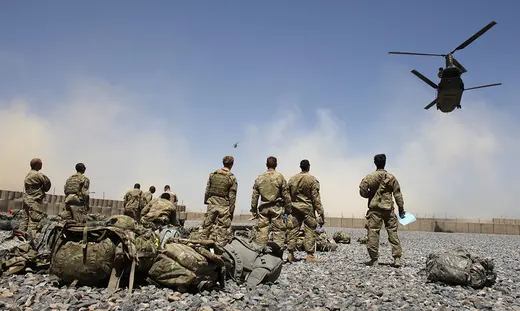NEW YORK, Apr 15 (APP): : A leading American newspaper has confirmed what Pakistan has always said that the terrorist groups based in Afghanistan are using, in their cross-border attacks, sophisticated weapons left behind by U.S. troops during 2021’s withdrawal from the war-torn country.
“Many of the weapons wound up across the border in Pakistan, at arms bazaars and in the hands of insurgents, illustrating how the consequences of America’s failed war continue to reverberate years after the fall of Kabul to the Taliban,” The Washington Post said in an investigative report, pointing out that some of those arms were used in last month’s deadly attack on the Jaffar Express train in Balochistan.
According to the newspaper, an M4A1 carbine rifle built by American manufacturer Colt was recovered from the site of the attack. The rifle’s serial number indicated that it was part of billions of dollars worth of weaponry sent to US forces in Afghanistan, who abandoned much of their equipment during their hasty exit.
“After a decade of progress against militants, Pakistan is now struggling to contain multiple insurgencies ….fueled in part by American weapons,” the Post reported from Peshawar in a team coverage.
“U.S. assault rifles, machine guns and night-vision goggles, originally meant to help stabilize Afghanistan, are now being used by the Pakistani Taliban (TTP) and other groups to wreak havoc across this nuclear-armed nation,” the Post said, citing militants, weapons traders and government officials.
“They have the latest American-made weapons,” Ahmad Hussain, 35, a Pakistani special forces constable, who was critically injured in a targeted nighttime attack in northwestern Pakistan last year, was quoted as saying. “They could see us,” he said, “but we couldn’t see them.”
The report said, “In May, Pakistani officials gave The Washington Post access to dozens of weapons that they said were seized from captured or killed militants. After months of inquiries, the U.S. Army and the Pentagon confirmed to The Post that 63 weapons that were shown to reporters had been provided by the U.S. government to Afghan forces. Most were M16 rifles, alongside several, more-modern M4 carbine models. Pakistani officials also displayed a handful of PVS14 night-vision devices…”
After the March 11 train attack on Jaffer Express, for which the Balochistan Liberation Army (BLA) claimed responsibility, Pakistani officials provided serial numbers for three U.S. rifles allegedly used by the attackers. At least two came from U.S. stocks, the Post said, citing records obtained by The Post through the Freedom of Information Act.
“The presence of US advance weapons … has been an issue of profound concern for the safety and security of Pakistan,” the Pakistani Foreign Ministry’s statement in late January that was highlighted by the Post.
In February, President Donald Trump threatened to permanently cut aid to Afghanistan unless the Taliban returns U.S.-provided military equipment, saying, “We left billions, tens of billions of dollars’ worth of equipment behind … all the top-of-the-line stuff … I think we should get a lot of that equipment back.”
”His remarks have reignited hope in Islamabad that the United States will move more decisively to account for its missing military gear,” the Post noted, adding that most however believe it is already too late to stem the flow of illicit arms.
Responding to President Trump’s push for recovery of American weapons, Zabihullah Mujahid, the Taliban-led government’s chief spokesman, said, “They’re now the property of Afghanistan. No one can take them away from us.”
Michael Kugelman, a South Asia analyst, said that Pakistan risks “falling back into that terrible period between 2009 and 2014, when the country was a major magnet for terrorism.”
When the Taliban took control of Afghanistan in August 2021, more than $7 billion in U.S.-provided military equipment was still in the country, a report by the Special Inspector General for Afghanistan Reconstruction, or SIGAR, estimated in 2023. The U.S. military had an uneven record of keeping track of weapons provided to the Afghans, SIGAR concluded, which was exacerbated by its “abrupt and uncoordinated” withdrawal.
More than a quarter-million rifles were left behind, SIGAR estimated, as well as nearly 18,000 night-vision goggles.
“Just after the Taliban takeover, the latest night-vision devices were sold at a scrap rate,” Raz Muhammad, 60, a Pakistani weapons trader, was quoted as saying. Around August 2021, the devices, which retail for about $2,000, were being sold for less than $300, he estimated. Insurgents have paired night vision and thermal equipment with small drones to attack troops with more precision, said Zaheer Hassan, a major in the Pakistani army.
“The battle has become much more dangerous,” said Hassan, who was injured in an attack last year. Verification requests from The Post revealed occasional slapdash recordkeeping in a Defense Department database that tracks small arms and light weapons. Among the recovered weapons were three M203 grenade launchers that were incorrectly listed as rifles in the database. The launchers attach to the underside of rifles, and someone may have confused the two serial numbers when documenting them, officials said.
Among the other items recovered by Pakistani authorities and shown to The Post were sets of U.S. body armor and piles of ammunition. The Pentagon left behind millions of rounds, SIGAR found, including ammunition for heavy weapons that can penetrate vehicles and bring down aircraft.
Along Pakistan’s porous border with Afghanistan, illicit weapons bazaars have long done business with militants and other criminals. At Darra Adamkhel, a town south of Peshawar, vendors, according to the Post, say the market dates back to the first Anglo-Afghan war, in the mid-19th century, when this part of Pakistan was contested between Afghan forces and the British.
But the market’s most dramatic days, at least in recent memory, were prompted by the U.S. withdrawal from Afghanistan. “The market was flooded with American weapons,” recalled Raz Muhammad. “Demand was high,” said Qari Shuaib Bajauri, a senior TTP member, adding that his fighters benefited from plummeting prices and abundant supplies. He noted that the boom began even before the U.S. had fully withdrawn from Afghanistan, as a growing number of cities fell to the Afghan Taliban.
But the market’s busiest days are over as Pakistani security forces raided regional markets and arrested vendors.
Recently released material shows TTP militants with U.S.-made night-vision devices, M4s with thermal optics and rifle-mounted infrared lasers.
A United Nations report last year concluded that Afghan Taliban “rank and file” directly supply the group with weapons and equipment.
APP/ift

